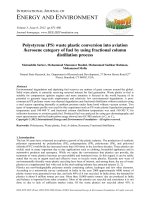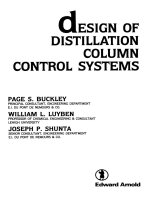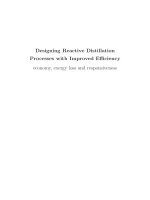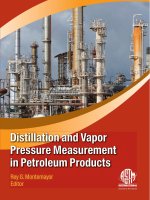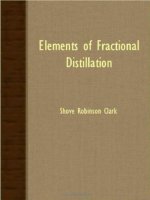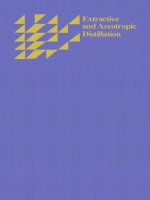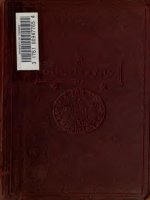fractional distillation (1903)
Bạn đang xem bản rút gọn của tài liệu. Xem và tải ngay bản đầy đủ của tài liệu tại đây (11.77 MB, 304 trang )
FRACTIONAL
DISTILLATION
BY
SYDNEY
YOUNG, D.Sc.,
F.R.S.
PROFESSOR OF
CHEMISTRY
IN UNIVERSITY
COLLEGE,
BRISTOL.
WITH
SEVENTY-TWO ILLUSTRATIONS
ILonbon
MACMILLAN AND
CO.,
LIMITED
NEW
YORK : THE
MACMILLAN COMPANY
1903
All
rights
reservtd
RICHARD CLAY AND
SONS,
LIMITED,
BREAD STREET
HILL,
B.C.,
AND
BUNGAV,
SUFFOLK.
PREFACE
DURING
the
past
eighteen
years
I
have been
engaged
in
investigations
which
necessitated the
preparation
of
chemical
materials
in
the
purest
possible
state,
and as
the
great
majority
of these
substances
were
liquids,
the
process
of
fractional distillation
had,
in
most
cases,
to be
resorted
to for
their
purification.
The
difficulties
I
met with
in
some of
the
separations
led
me to make a careful
investigation
of the
whole
subject,
and
I
was
thus enabled
to
devise
some
new methods
and
forms of
apparatus
which
have
been
described
from
time
to
time
in
various
scientific
journals.
It is
in
the
hope
that the solution of the difficulties
which so often occur
in
carrying
out
a
fractional distillation
may
be rendered
easier,
and that the
value
and
economy
of
highly
efficient still-heads
in
laboratory
work
may
come to
be
more
widely
recognised
than is
generally
the case at
present,
that this book has been written.
My
sincere thanks are
due to Professor
J.
Campbell
Brown
for the loan
of
valuable
ancient works
by
Libavius
and
Ulstadius,
from which
Figures
2
and 34 have
been
taken
;
to
my
colleague,
Dr. F.
E.
Francis,
for
reading
the
proofs,
and for much valuable
assistance
in
compiling
the
vi
PREFACE
index
;
and to
Professor R.
A.
Gregory
and
Mr.
A.
T,
Simmons,
B.Sc.,
for
many
useful
suggestions
regarding
the
arrangement
of the MS.
and for the
perusal
of
the
proofs.
In
the
description
and illustration
of the stills
employed
in
commerce
I
have derived
much
assistance
from articles
in
Thorpe's
"Dictionary
of
Applied Chemistry"
and
Payen's
"
Precis
de
Chimie Industrielle."
I
have made
much use
of the
experimental
data of
Brown,
Konowaloff, Lehfeldt,
Zawidski and other
observers,
and
have,
as
far as
possible,
made due
acknowledgment,
but in
some of
the tables this has not been
practicable.
Several
fractional distillations and numerous
experiments
have been
carried
out while the book was
being
written
and
the
results
have
in
many
cases not been
published
elsewhere.
S.
Y.
BRISTOL,
Anyn.it
1903.
CONTENTS
CHAPTER I
PAF,
INTRODUCTION APPARATUS
REQUIRED
1
CHAPTER
II
THE
BOILING
POINT OF A PURE
LIQUID
22
CHAPTER III
VAPOUR
PRESSURES OF MIXED
LIQUIDS
32
CHAPTER IV
-
BOILING
POINTS OF
MIXED
LIQUIDS
51
CHAPTER V
COMPOSITION OF
LIQUID
AND
VAPOUR PHASES
;
EXPERIMENTAL
DETERMINATIONS
71
CHAPTER
VI
COMPOSITION OF
LIQUID
AND
VAPOUR
PHASES,
CONSIDERED THEO-
RETICALLY
89
CHAPTER
VII
DIRECTIONS
FOR CARRYING OUT A
FRACTIONAL
DISTILLATION . . 114
CHAPTER
VIII
THEORETICAL RELATIONS BETWEEN THE
WEIGHT AND
COMPOSITION
OF DISTILLATE 144
CHAPTER
IX
RELATION
BETWEEN THE BOILING POINTS
OF
RESIDUE
AND
DISTILLATE 150
CONTENTS
CHAPTER
X
PAGE
MODIFICATIONS
OF THE STILL-HEAD
154
CHAPTER
XI
MODIFICATIONS
OF THE STILL-HEAD
(continued)
',
DEPHLEGMATORS .
171
CHAPTER
XII
MODIFICATIONS
OF THE STILL-HEAD
(continued);
"REGULATED"
OR
"CONSTANT
TEMPERATURE" STILL-HEADS
180
CHAPTER
XIII
CONTINUOUS
DISTILLATION
186
CHAPTER
X[V
FRACTIONAL
DISTILLATION
WITH
AN
IMPROVED STILL-HEAD .
.
.
191
CHAPTER
XV
DISTILLATION ON THE
MANUFACTURING
SCALE 196
CHAPTER
XVI
FRACTIONAL
DISTILLATION AS
.A
METHOD OF
QUANTITATIVE
ANALYSIS
204
CHAPTER
XVH
METHODS BY
WHICH
THE COMPOSITION OF MIXTURES OF CONSTANT
BOILING
POINT MAY BE DETERMINED
223
CHAPTER
XVIII
INDIRECT
METHOD
OF SEPARATING THE COMPONENTS OF
A MIXTURE
OF
CONSTANT
BOILING POINT .
.
231
CHAPTER
XIX
GENERAL REMARKS.
PURPOSES FOR WHICH FRACTIONAL DIS-
TILLATION
IS
REQUIRED.
INTERPRETATION OF EXPERIMENTAL
RESULTS.
CHOICE OF
STILL-HEAD,
NUMBER OF
FRACTIONS,
ETC.
239
APPENDIX
269
INDEX
.
-27 )
LIST OF
ILLUSTRATIONS
FIG. PAGE
1.
Still
employed
by
the Alexandrian
Chemists
3
2. Water condenser
described
by
Libavius
(1611)
3
3.
Ordinary
modern
apparatus
for distillation 4
4. Another
ordinary
form of
apparatus
5
5.
(a
and
b).
Inner tube
of
condenser,
bad and
good
forms 6
6. Guard for Bunsen burner 8
7.
Still heated
by
steam
8
8. Condenser
for
volatile
liquids
17
9.
Distillation under
reduced
pressure
18
10.
Modified receiver
for
above
(Thome's)
19
11.
,,
(Bredt's)
19
12.
,,
(Brtthl's)
20
13.
Vapour pressure
curve 22
14.
Vapour
pressures
of mixtures of
alcohols with water .
.
46
15.
Mixtures
of
maximum
vapour pressure
47
16. Aniline
Still
56
17.
Boiling
points
of
mixtures of chlorobenzene
and bromo-
benzene
57
18.
Apparatus
for
determining
the
boiling
points
of mixtures 58
19. Deviation of
boiling
point-molecular
composition
curve
from
straightness (methyl
and
propyl
acetates)
61
20.
Composition
of
liquid
and
vapour
phases.
Brown's
apparatus
73
6
x
LIST OF ILLUSTRATIONS
FIG.
PAGK
21.
Composition
of
liquid
and
vapour phases.
Lehfeldt's
apparatus
75
22.
Composition
of
liquid
and
vapour phases.
Zawidski's
apparatus
77
23.
Composition
of
liquid
and
vapour phases.
Gahl's
apparatus
81
24.
Composition
of
liquid
and
vapour phases.
Carveth's
apparatus
82
25.
Variation
of c with molecular
percentage
of A
(ethyl
alcohol and
benzene)
103
26.
Partial and
total
pressures against
molecular
fractional
amount of
A
(ethylene
dichloride and
benzene)
. .
.
109
27.
Fractional
distillation
of mixture of
benzene and
toluene.
Total
weight
of distillate
plotted against temperature
.
122
28.
(a
and
b).
Fractional
distillation of
mixture of
methyl,
ethyl
and
propyl
acetates. Total
weight
of
distillate
plotted
against temperature
137
and
138
29.
Separation
of
pentanes
from
petroleum
139
30.
Relation
between
weight
of
liquid
distilled and com-
position
of distillate Two
components.
First dis-
tillation 145
31
and 32.
Relation between
weight
of
liquid
distilled and
composition
of distillate Two
components.
Later
distillations 146
33
(a to/).
Relation
between
weight
of
liquid
distilled
and
composition
of distillate
Three
components
.
.
147
34. Modified
still-heads
;
Ulstadius' still
154
35.
(a
and
6).
"
Rod aad Disc
"
still-heads
163
36.
"Pear" still-head
165
37.
"Evaporator"
still-heads;
original
form
166
38.
,, ;
(one
section)
.
166
39.
;
modified
,,
(
,,
)
.
168
40.
Linnemann
dephlegmator
171
41.
Glinsky
172
LIST OF
ILLUSTRATIONS xi
FIG. PAGE
42.
Le
Bel-Henninger
dephlegmator
172
43.
(,
6,
c).
Young
and Thomas
dephlegmator
173
44.
Brown's
"
regulated temperature
"
still-head 181
45.
Combined
dephlegmator
and
regulated
temperature
still-
head
183
46.
Continuous distillation
Carveth's
apparatus
187
47.
,,
,,
Lord
Rayleigh's apparatus,
modi-
fied
so as to
separate
three
components
189
48. Mansfield's
still
197
49.
Coupler's
still
198
50. French
column still 199
51. Section of
dephlegmator
Dubrunfaut's 200
52.
(a
and
6).
Section of
dephlegmator Egrot's
200
53 and 54.
,,
,,
Savalle's
201
55.
,,
CofFey's
201
56.
Section of Pistorius still-head 201
57.
(modified)
201
58.
The
"
Coffey
"
still 202
59.
Specific gravities
of distillates
from mixtures
of
ethyl
alcohol and water
226
60.
Vapour pressure-molecular
composition
curve
;
carbon
disulphide
and
methylal
227
61. Distillation of
aqueous hydrochloric
acid.
Composition
of
liquid
and
vapour
228
62.
Carbon
disulphide
and
methylal.
Relative
weights
in
liquid
and
vapour
229
63.
Carbon
disulphide
and
methylal. Logarithms
of
relative
weights
229
64.
Carbon
disulphide
and
methylal.
Relation between
c
(Brown)
and
molecular
percentage
of carbon
disulphide
230
65. Curve
illustrating
the distillation
of a substance which
contains
only
much less volatile
impurities
240
66. Curve
illustrating
the distillation
of
a
substance which
contains
only
much more volatile
impurities
243
xii LIST OF
ILLUSTRATIONS
FIG.
PAGE
67.
Curve
illustrating
the distillation
of a
substance which
contains
bnly slightly
less volatile
impurities
243
68.
Curve
illustrating
the distillation of
a substance which
contains
only slightly
more volatile
impurities
244
69.
Curve
illustrating
the distillation of a substance which
contains both much more and much less volatile im-
purities
245
70.
Curve
illustrating
the distillation of a
substance which
contains
both
slightly
more and
slightly
less
volatile
impurities
. 245
71.
Boiling point-molecular composition
curve for
ethyl
alcohol
and water
248
72.
Fractional
distillation of
petroleum
the
hexanes . .
.
257
FRACTIONAL
DISTILLATION
CHAPTEE I
INTBODUCTION
Object
Of
Distillation.
The
object
of
distillation
is
the
separation
of a
volatile
liquid
from
a non-volatile
substance
or,
more
frequently,
the
separation
of
two or
more
liquids
of
different
volatility.
If
only
one
component
of a
mixture
is
volatile,
there is
no
difficulty
in
obtaining
it in
a
pure
state
by
distillation,
and
in
many
cases the
constituents of a
mixture
of two or
more
volatile
liquids
may
be
separated though
frequently
at
much
cost
of
time and
material
by
means of
the
simple
apparatus
described
in
this
chapter.
For the
fractional
distillation of such
complex
mixtures as
petroleum
or
fusel
oil,
the
improved
still-heads
described
in
Chapters
X
to XII
must be
employed.
Quantitative
Analysis
by
Distillation.
The
determina-
tion,
by ordinary
analytical
methods,
of the
relative
quantities
of two or
more
organic compounds
in
a
mixture
is
often
a
matter
of
great difficulty,
but,
in
many
cases,
the
composition
of
the
mixture
may
be ascertained
approxi-
mately
and,
not
seldom,
with considerable
accuracy
from
the
results
of a
single
distillation,
if
a
very
efficient still-head
be
B
2
FRACTIONAL
DISTILLATION CHAP.
employed.
It is
hoped
that
this method
may
prove
of con-
siderable value.
Difficulties
Encountered.
The
subject
of
fractional
distillation
is
full of
interest
owing
to
the
fact
that difficulties
so
frequently
occur,
not
only
in
the
experimental
work,
but
also
in
interpreting
the results
obtained.
In the distillation
of
petroleum,
such
difficulties are of
common occurrence
and are
due
to
one
or other
of
three
causes
:
(a)
to the
presence
of two
substances,
the
boiling
points
of which are
very
close
together
;
(6)
to the
presence
of one or
more
components
in
relatively very
small
quantity
;
(c)
to
the formation of mixtures of constant
boiling
point.
The
separation
of two
liquids
which boil
at
temperatures
even 20
or 30
apart,
such as
ethyl
alcohol and
water,
or
benzene
and
isobutyl
alcohol,
may
be
impossible
owing
to
the
formation of a
mixture
of
minimum
or,
less
frequently,
of
maximum
boiling point.
It
is, indeed,
only
in
the case of
substances
which
are
chemically closely
related to
each other
that
the statement
can
be
definitely
made
that
the
difficulty
of
separating
the
components
of a
mixture diminishes as
the
difference
between their
boiling
points
increases.
In
any
other
case,
we must
consider the relation between
the
boiling points,
or
the
vapour
pressures,
of
mixtures of the
substances
and
their
composition,
and unless
something
is
known
of the
form of the curve
representing
one
or
other of
these
relations,
it is
impossible
to
predict
whether
the
separation
will
be an
easy
one
or, indeed,
whether
it will
be
possible.
The
form of
these curves
depends
largely
on the chemical
relationship
of the
components,
and
it
is
now
possible,
in
a
moderate
number of
cases,
to form an
estimate,
from
the
chemical constitution of the
substances,
of
the extent
to
which
the curves
would
deviate from the normal
form,
and
therefore to
predict
the
behaviour
of
a
mixture
on
distillation,
ANCIENT
APPARATUS
Fractional distillation is
frequently
a
very
tedious
process
and there is
necessarily
considerable
loss of material
by
evaporation
and
by
repeated
transference
from the
receivers
to the
still,
but
a
great
amount of both time
and
material
may
be saved
by
the use of
a
very
efficient
still-head
;
and
when the
object
of the distillation
is
to ascertain the com-
position
of
a
mixture,
very
much
greater accuracy
is
thereby
attained.
APPABATUS.
Ancient
Apparatus.
The
process
of distillation is
evidently
a
very
ancient
one,
for Aristotle
(1)*
mentions
that
pure
water
may
be obtained
from sea-water
by
evaporation,
but he
does not
explain
how the condensation
of
the
vapour
can
be effected. A
primitive
method of condensation
is
described
by
Dioscorides
and
by Pliny,
who state that
an
Fio. 1.
Alexandrian still with
head,
or
alembic.
Fio. 2. Ancient still with
water
condenser.
oil
may
be
obtained
by
heating
rosin in
a
vessel,
in
the
upper
part
of which
is
placed
some
wool.
The
oil
condenses
in
the
wool
and
can
be
squeezed
out of
it.
The
Alexandrian
chemists
added a
second
vessel,
the
head
or
cover,
called
by
the
Arabians the
alembic,
to the
boiler
*
The
numbers in
brackets
refer
to the
bibliography
at the
end of
the
chapters.
B
2
4
FRACTIONAL
DISTILLATION
CHAP.
or
still,
and a
simple
form of
apparatus
used
by
them
is
shown
in
Fig.
1.
Later
on,
the
side tube was
cooled
by
passing
it
through
a
vessel
containing
water.
The
diagram,
Fig.
2,
is taken
from
Libavius,
Syntagma
Alchymice
Arcanorum,
1611.
Modern
Apparatus.
The
apparatus
employed
at the
present
time is similar
in
principle,
but,
in
addition,
a
thermometer
is used to
register
the
temperature.
In
Fig.
3
FIG.
3.
Ordinary
still,
with
Liebig's
condenser.
the
ordinary
form of
apparatus
is
shown,
and we
may
distinguish
the
following parts
: The
still,
A
;
the
still-
head,
B
;
the
Liebig's
condenser, c,
in
which
the
vapour
is
deprived
of heat
by
a current of cold water
;
the
receiver,
D
;
the
thermometer,
E. The still is
usually
heated
by
means of a Bunsen burner.
The
flask or still
is fitted with a
cork
through
which
passes
the
still-head,
and the side
delivery
tube
from
the
still-head
passes
through
a
second
cork
in
the
condensing
tube.
For
liquids
which
boil
at a
high
temperature,
or
which act
chemically
on
cork,
it is
more convenient to have
the
still
and
still-head
in
one
piece
and to
elongate
the
STILL
AND STILL HEAD
Fio.
4.
Modified
form of still
with condenser.
delivery
tube
so
that
it
may pass,
if
necessary,
through
the
Liebig's
condenser
(Fig.
4).
The
Still.
If
a
glass
flask
is used
it
should
be
globular,
because
a
flat-bottomed
flask
is liable to crack
when
heated
with
a
naked
flame.
It should
not
be
larger
than
is
necessary
for
the amount
of
liquid
to
be
distilled.
The
Still-head.
The still
-head should
not be
very
narrow,
or
the thermometer
may
be
cooled
slightly
below
the
temperature
of
the
vapour.
It
is a
good
plan
to seal
a
short
length
of
wider
tubing
to
the
still-
head near
the
bottom,
leaving
a sufficient
length
of
the
narrower
tubing
below
to
pass through
the cork
in
the
still,
as
shown
in
Fig.
3.
The
still-head,
as
supplied
by
dealers,
is
often
too short.
It
should,
if
possible,
be
long enough
for
the thermometer
to be
placed
in
such a
position
that not
only
the
mercury
in the bulb
but also that in
the
stem
is heated
by
the
vapour
of the
boiling liquid
;
otherwise a troublesome and
somewhat
uncertain correction must be
applied
(p.
12),
and,
if the distillation is not
proceeding
quite steadily,
a
little
air
may
be
carried
back from
time
to time as
far
as
the
thermometer
bulb and
the
temperature
registered
by
the thermometer will then
fluctuate
and
will,
on the
whole,
be too low
(p.
28).
The
Condenser.
If
the
boiling point
of the
liquid
to
be
distilled is
higher
than about
170,
the
condensing
tube
6 FRACTIONAL
DISTILLATION
CHAP.
should not be
cooled
by
running
water
for
fear
of
fracture.
A
long
tube should be used and
the
cooling
effect
of the
surrounding
air will then
be
sufficient.
When a
Liebig's
condenser is used
there
is
no
advantage
in
having
either the inner or the
outer tube
very
wide
;
an
internal
diameter of
7
or
8
mm. is sufficient for
the
inner,
and of 15 mm. for the outer
tube.
If
the outer
tube is
much
wider
it is
unwieldy,
and,
when filled with
water,
it
is
inconveniently
heavy.
A
mistake that is
rather
frequently
made
may
be referred
to
here.
It
is
usual
to
seal
a
short
wide
tube to the
long,
narrow
condensing
tube
for the
insertion
of
the
delivery
tube from
the
still-head.
The tubes are
often
a
_
sealed
together
in
such
a
way
that
when
the
distillation
is
proceeding
a little
pool
of
liquid
collects
FIG. 5.
Condensing
tube
of
(a)
faulty,
(b)
correct,
,
,-,
.
,.
/T7I
.
construction.
at the
junction
(Fig.
5
a),
and,
in
the
frac-
tional
distillation
of a small
quantity
of
liquid,
the error
thus introduced
may
be
serious. The fault is
easily
remedied
by heating
the wide tube close to the
junction
with
the narrow
one
until the
glass
is soft and
then
drawing
it
out
very
gently
until
it
has the form shown
in
Fig.
5 b.
When
a
long
still-head is
used,
it is
advisable to
bend
the
narrow tube
just
below its
junction
with the
wider
one,
so
that the condenser
may
be vertical
in
position
instead of
sloping
gently
downwards.
Much less
space
is
thus
taken
up
on
the
laboratory
bench,
and the
receivers are somewhat
more
conveniently manipulated.
The
Source
Of Heat.
For
laboratory purposes
an
ordinary
Bunsen
burner
is
usually
employed.
Wire
gauze,
asbestos
cardboard,
sand
baths,
or
water
or oil baths
i
SOURCE
OF HEAT
7
are
not,
as a
rule,
to
be
recommended,
because
the
supply
of
heat can be much more
easily regulated
without
them,
and
a round-bottomed
flask,
if
properly
blown,
is so thin
walled that
there
is no
danger
of fracture
when the
naked
flame
is
applied.
The flask should be so
placed
that
the
flame
actually
comes
in
contact
with the bottom of
it
;
this
is
especially necessary
when
the
liquid
to be distilled
is liable
to
"bump." Many
substances,
such
as
carbon
disulphide,
which
boil
quite
regularly
under
the
ordinary
atmospheric
pressure,
bump
more
or less
violently
when the
pressure
is
greatly
reduced,
unless
special precautions
are
taken. Under
a
pressure
of
361
mm. carbon
disulphide
boils
at
25,
and
if
a
quantity
of it be
distilled under
this
pressure
with the
flame
placed
some
distance below
the bottom of
the
flask,
it
may happen
that
the whole of the
carbon
disulphide
will
pass
over
without
any
ebullition whatever
taking
place.
The
liquid,
however,
in
these
circumstances,
becomes
con-
siderably superheated,
and
if
a bubble
does form
there will
be
a
sudden and
perhaps
violent
rush of
the
extremely
inflammable
vapour.
If,
however,
the
top
of
the
burner
be
placed
only
about
2
mm.
below
the
bottom of
the
flask,
so that
the minute flame touches
the
glass,
ebullition
will
take
place
quietly
and
regularly.
There
are
liquids
which
cannot be
prevented
from
bump-
ing
in
this
way,
and the best
plan
is then to
add a few small
fragments
of
porous porcelain
[a
clay pipe
broken
in
small
pieces
answers
the
purpose
very
well]
or
pumice-stone,
or
both,
or a
number of small tetrahedra of silver
or
platinum.
A
water
or
oil bath need
only
be used when
a solid sub-
stance
is
present
in
the flask
as,
for
instance,
when
a
liquid
is
distilled over
lime
or
phosphorus pentoxide,
or when
the
liquid
is
liable
to
decompose
when heated with the
naked
flame.
It
is
customary
to
employ
a
water-bath for the
distillation
of
ether,
but
it
is doubtful
whether
this is
necessary
or even
advisable
except
in
the
case
of the
ethereal solution
of a
FRACTIONAL
DISTILLATION
CHAP.
solid
substance
or
one
that
will not
bear
heating
much
above
100.
When an accident
occurs
it
is almost
invariably
because,
owing
to
"
bumping,"
or
to the distillation
being
carried on
too
rapidly,
some
of
the
vapour escapes
con-
densation
and
comes
in
contact
with
a flame
in
the
neigh-
bourhood,
generally
that
below the water-bath.
If
a
naked
flame were
used
the
distillation could be
much
more
easily
regulated,
and
there
would
probably
be
really
less
danger
than if
a
water-bath
were
employed.
Protection of
Flame
from
Draughts.
In
order
that
satisfactory
results
may
be
obtained it
is
necessary
that
FIG. C.
Simple
flame
protector.
B
FIG.
7. Still with steam
jacket.
the
distillation
should
proceed
with
great
regularity
and the
heat
supply
must
therefore not be
subject
to
fluctuations.
The
most
important
point
is to
guard
against draughts,
and,
to do
this,
the
ordinary
conical flame
protector
may
be
used,
or a
simple
and efficient
guard
may
be
made from a
large
beaker
by
cutting
off the bottom and
taking
a
piece
out of
the
side
(Fig.
6).
Steam
as Source of Heat.
On
the
large
scale,
the
still
is
frequently
heated
by
steam under
ordinary
or
increased
pressure
(Fig. 7).
The
steam
is
introduced
through
the
pipe
A,
and the condensed
water
is
run off at B.
I
CALIBRATION
OF
THERMOMETERS
9
The Thermometer.
In
carrying
out a fractional
distillation one
must be
able,
not
only
to
read a constant
or
nearly
constant
temperature
with
great accuracy,
but
also to take
readings
of
rapidly rising temperatures.
These
requirements
are best
fulfilled
by
the
ordinary
mercurial
thermometer,
which
is
therefore,
notwithstanding
its
many
drawbacks,
used
in
preference
to
the
air or the
platinum
resistance
thermometer.
If
accurate
results
are to
be
obtained
the
following points
must
be
attended to.
1.
Calibration.
The thermometer must be
carefully
calibrated,
and it would be a
great advantage
if all ther-
mometers
were
compared
with an
air
thermometer,
for
two
mercurial
thermometers,
constructed
of
different varieties
of
glass,
even
if
correct
at 0" and
100,
will
give
different
and incorrect
readings
at other
temperatures,
more
espe-
cially
at
high
ones,
for
various reasons :
(a)
In
the first
place,
it is
impossible
to
obtain
an
abso-
lutely cylindrical
capillary
tube,
and
therefore the volume
corresponding
to
a
scale
division cannot
be
quite
the same
in all
parts
of
the
tube. Various methods have been
de-
vised
for
calibrating
the stem
(2,
3),
but even
when this is
done there
remain other sources of error.
(6)
The
position
of
the
mercury
in
the stem at
any
temperature
depends
on the
expansion
both of the
mercury
and the
glass,
and,
for both
substances,
the
rate of
expansion
increases
with rise
of
temperature.
(c)
Different
kinds of
glass
have different rates of
expan-
sion,
so
that two thermometers made of
different
materials
even
if the
capillary
tubes
were
perfectly
cylindrical
would
give
different
readings
at the
same
temperature.
It
is
therefore
necessary
to
compare
the
readings
of
a
mercurial
thermometer
with those of an
air
thermometer,
or
of
another
mercurial thermometer
which has
previously
been
stan-
dardised
by
means of
an
air thermometer.
Or,
instead
of
this,
a number of
fixed
points
may
be
determined
by
